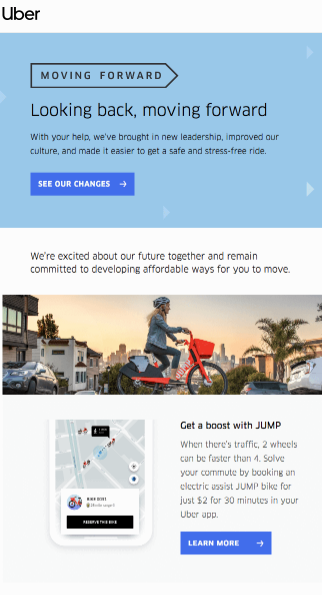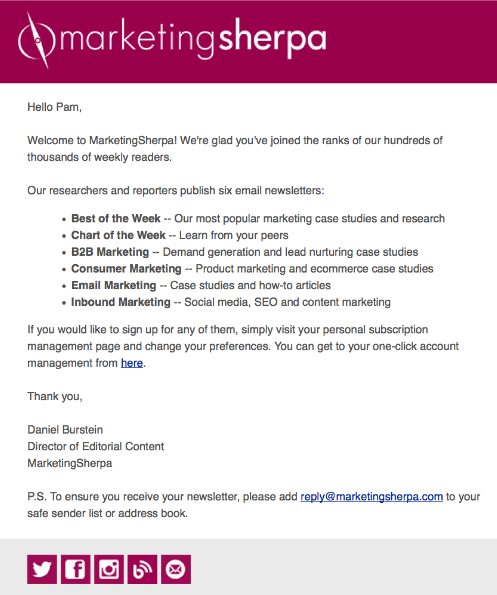8 Types of B2B Email Campaigns for Your Next Marketing Spree

You’d have to be insane to imagine an online marketing campaign without email as your main tool. Why? Because email marketing will reap you the best ROI and conversion rates. Are you utilizing the right kind of email marketing tools and techniques for your B2B email campaigns?
A recent study by SuperOffice claims that only 87% B2B companies use email marketing and only 31% B2B email marketers feel that email marketing can significantly impact revenue. Email marketing actually might be an unexplored arena for the success of B2B companies. According to the Data and Marketing Association, email marketing has an ROI of $51 for every $1 spent.
Let’s look into the different types of email marketing campaigns that’ll enhance profits and strengthen relationships with your B2B audience.
Best B2B Email Campaign Examples
1. Announcement Emails
Keep the client informed of any newsworthy information from your end. Recent development in your company could easily make up the announcement content.
- Planning to launch or have launched a new product?
- Came up with a new pricing range?
- Just published a really good post your client might be interested in?
- Made some changes to your website?
- Got recognition or an award?
- Have an engaging audiovisual that gives an insight into your business workings and process?
You get the drift. Keep subscribers updated on your development that affects their business.

2. Follow-up Emails
This type of b2b email campaign is used to follow up with a customer’s activity on your website or their response to your message.
- Order status: Once a customer places an order, use an email to communicate the same in the form of an acknowledgment or reconfirmation. You can provide information regarding order status, tracking system, expectation date, grievance redressal, etc. Similarly, update order arrival and delivery done. Besides simply updating their order status, go ahead and provide discount coupons/scratch cards, etc.
- Registration follow-up: Say when a potential client signs up for your newsletter/updates, you would want to acknowledge their action through email. Say thank you followed by a list of relevant content, to begin with. Talking about thanking the customer, we have the email type solely dedicated to outpouring gratification from your end and nothing else.
- Thank You email: A famous writer once said, ‘silent gratitude isn’t much to anyone’.
…it can surely change your business. And why even hesitate when ‘Thank You’ emails can be done so easily? This is one email campaign type where you won’t have to ponder too much on. Send automated ‘thank you’ responses to positive actions taken by customers/users. You can also attach links to useful resources and contents on your blogs or pages curated according to the kind of action taken. If you value your client, make them feel valued.
- Welcome emails: This is the email version of rolling out the welcome mat. The welcome email is the initial step of establishing a great relationship with your client. Some points to remember:
- Naturally, it should go with the ‘thank you’ note
- Mention or provide links about your business/site
- Do give communication channels through which they can reach out to you. Plus, use a reply-able sender address
- Auto-senders are great. Still, personalization is best
- Give a glimpse of what you have in store for them
- Ask their preference, they’ll appreciate it — time, frequency, type of email content, and so on. Provide a quick optimization option
- Don’t forget the CTAs
- Give new subscribers the choice to opt out whenever they want. This might sound detrimental, but it’s actually not
Welcome emails have high open rates, so don’t miss out on them.

- Reminders: Hath thou forgotten thy Shopping Cart? These are emails with the sole purpose to remind customers of forgotten or deserted shopping carts. If you think the cart abandonment scenario doesn’t call for a separate email campaign, think again. Online shopping carts dissertation is pretty common.
- Reminder emails must have CTAs strong enough to make them go back to their carts.
- The content that goes into such emails should reinforce why the client would need the items in the cart.
- This is also a good place to inform them of price drops among items in the cart. The more such information you provide, the better.
- Tidings of discounts, coupons and anything in between.
Someone registered for a course but hasn’t clicked on the email link to the content? Cast the net, secure the potential clients. You can send emails somewhere on the lines of — Hey, I see you haven’t accessed the XYZ course yet. Go on, take the free sessions while they last!
- Activation emails: A registered user yet to activate his or her account? An activation email can act either as a reminder or persuasion.
- Include proper, easy-to-understand instructions on how to activate the account/profile/subscriptions.
- Remind them why the activation would be worth their time.
- Feedback request emails: Use emails to ask for feedback from clients after they’ve used your service or visited your page. Keep feedback forms short and simple.
3. Events & Webinar Email Campaigns
Events and webinars are great ways to open up effective communication channels with clients. Dialogue exchange and brain-picking are made possible in such instances. Use the power of email marketing to enhance engagement and participation. Have an event coming up? Inform your customers and potential clients about the event as part of your email announcement campaign.
Pre-Event: Use email marketing to send invitations wherein you’ll provide all the necessary information around the webinar or event. Mention the ‘when and where’. Who will they get to interact with at the event? Also, give a brief of what the webinar will focus on i.e. in addition to simply mentioning the topic.
Share a link to the meet or a form to register. As always, make the invitation attractive. Optimize the subject line and the Call to Action.
Post-Event: Share snippets and knowledge from the held event/webinars. This should be specially targeted to those who missed the event. Give a brief glimpse of what went down in the webinar.
4. Curated Content
Present the client with a selection of your best content that would add value to their business. When you send curated emails, you do two great things for yourself and the customer:
- By curating the articles/posts in their inbox, you enhance content visibility. Most clients won’t be diligently browsing your site for what great content you have in store for them. So, tell them in the form of lists and summaries via email.
- Customers will like the fact that they’re given options right within their inbox. And if the content has been well-curated (with effective personalization), they’ll even thank you for it.
It pays well (in terms of relationship-building) to share high-value content from time to time, free from profit-based promotion. Businesses and people on your list are bound to appreciate it.
Newsletters
Curated content can be in the form of newsletters. This is a great email campaign type through which you can tell your brand stories. Tell your brand purpose, value, and experience to have an emotional connection with subscribers.
5. White Papers
For B2B marketing, it is often necessary to provide in-depth materials on topics that clients would usually look out for. Thus, your content though lengthy and info-laden content is likely to be well received by clients. Share links to well-researched white paper contents:
- Industry insights and analysis
- In-depth guides and tutorials
- Challenges and solutions for specific business area
- Relevant audience surveys
6. Case Studies
A case study is a perfect way to demonstrate to potential clients how good of a service you provide. This is the proof of your claim. Case studies will show in detail how other clients benefit from your business. Case study emails must have:
- How you scaled revenue growth of the client in case
- Client retention/engagement rates and
- How you turned their sales figures from x to y
- Share customer stories and testimonials
- Your case studies should be relevant to the industry of the potential client
7. Giveaways
These are the emails whose purpose is to disseminate time-sensitive offers. Nobody hates freebies, okay? You probably know your B2C audience love promo codes and all that. It’s the same case scenario in B2B. So, whenever, wherever you can dish out a free slice of your service, do it:
- Free trials of your products/services
- Demo sessions of your course/tutorials
- Use the scarcity or ‘time-limit’ trick
8. Re-engagement Email
Some of the subscribers in your list are bound to become inactive at some point of your marketing journey — Unsubing, spam listing, or engagement simply going cold due to various reasons. This happens especially when your content no longer resonates with the inactive list. Reengagement emails are designed to reestablish the connections between you and your clients.
- Show your company’s relevancy in the industry
- Reintroduce your brand; highlight development you’ve undergone
- Restate Unique Selling Points
- Tell the client how your service will benefit their business, extend a friendly hand
Reactivating inactive subscribers isn’t usually done too often. This type of campaign is best done once or twice a year.
The various types of email marketing for B2B are often run together to achieve the best marketing result. It is important to identify the client’s B2B needs and provide in-depth high value accordingly.

FAQs
The ideal way is to define your customer profile and understand your target audience. It is also important to:
a. Personalize your B2B email marketing campaign
b. Segment your list and include an effective call-to-action.
c. Have content that is highly effective, relevant, and taps into the main pain points and challenges.
A few types of B2B email campaign ideas that you should already be using include:
a. Welcome email
b. Promotional campaign
c. Seasonal campaign
d. Post-purchase follow-ups
e. Newsletter
f. Cart abandonment campaign
A few B2B email campaign ideas for your next promotion could include:
a. Personalization
b. Video content
c. Gifs
d. Focus on cart abandonment
e. Social proof
f. Creating habits
g. Introducing referral programs
Email marketing is all about building and nurturing client relationships and is also cited as one of the most cost-effective methods in B2B marketing. A study by Message Systems claims that 63% of marketers already feel that email offers the best ROI.
Latest Blogs
Learn how to rank on AI search engines like ChatGPT, Perplexity, and Gemini by optimizing your content for authority, structure, and relevance. Stay ahead in AI-driven search with this strategic guide.
Explore the best healthcare SEO services for your medical practice. Improve online visibility and effectively reach more patients in need of your services.
Discover top social media agencies specializing in banking solutions, enhancing financial services and driving engagement.
Get your hands on the latest news!
Similar Posts

Email Marketing
6 mins read
11 Tips to Design Impactful Email Banners

Design
9 mins read
7 Benefits of a Simple Mailer Design

Email Marketing
7 mins read